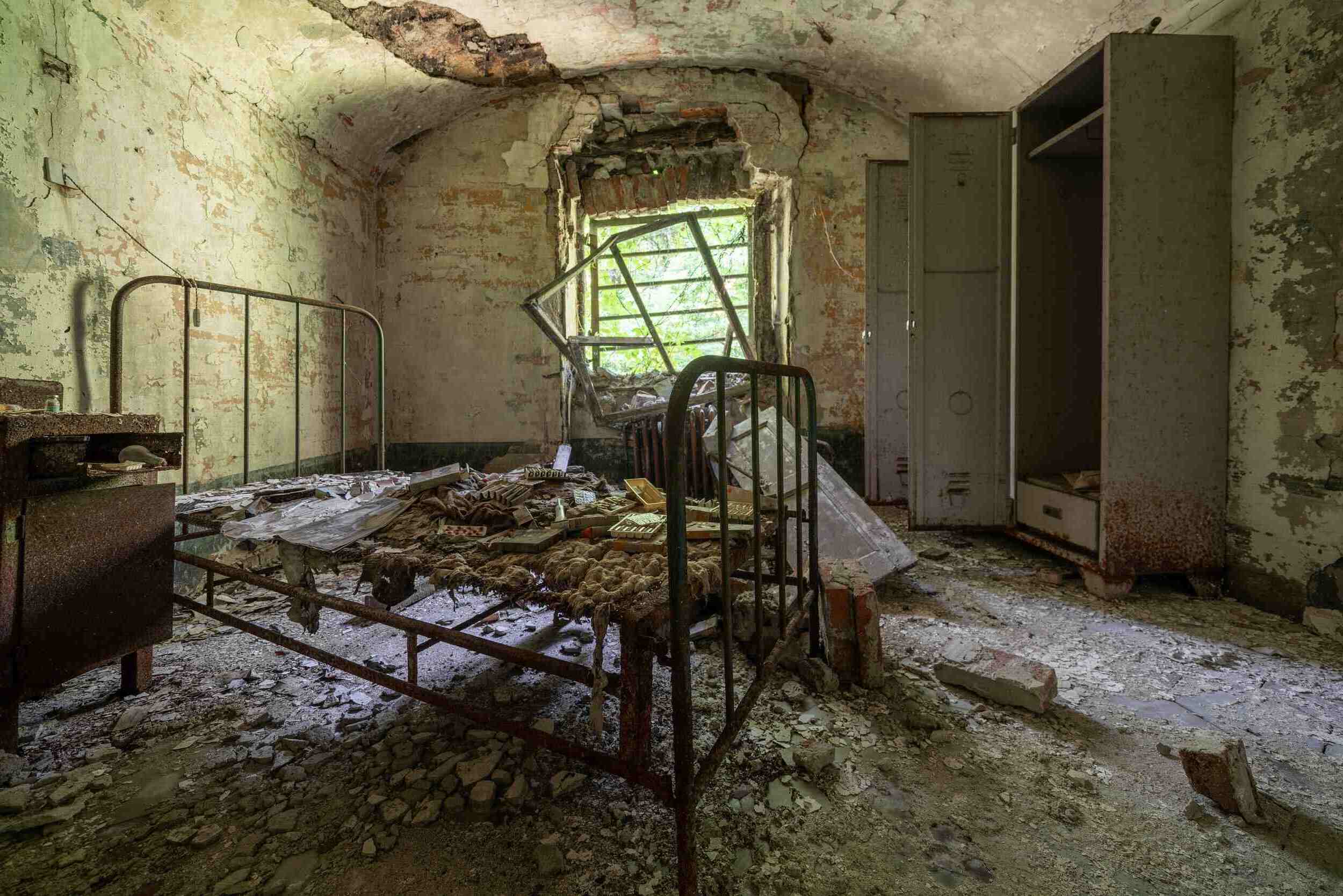
Why are abandoned asylums so haunting? These eerie structures, once bustling with patients and staff, now stand as silent witnesses to a dark chapter in mental health care. Originally intended to heal, many asylums became places of neglect, abuse, and despair. Overcrowding, inhumane treatments like ice pick lobotomies, and horrific living conditions turned these institutions into nightmares. Today, their crumbling walls and empty rooms whisper tales of suffering and lost hope. Exploring these abandoned sites offers a glimpse into the past, reminding us of the importance of humane and effective mental health care. Their haunting legacy serves as a stark warning against repeating past mistakes.
Key Takeaways:
- Abandoned asylums hold a dark history of inhumane treatments and overcrowding, reminding us of the need for more humane mental health care and continuous improvement in psychiatric treatments.
- Deinstitutionalization led to the abandonment of many asylums, impacting local communities and highlighting the importance of preserving these sites to educate and create a better future for mental health care.
The Dark History of Abandoned Asylums
Abandoned asylums are eerie reminders of a time when mental health care was often more about containment than treatment. These institutions, now crumbling and deserted, once housed thousands of patients under grim conditions. Let's explore some chilling facts about these places.
-
Topeka State Hospital: A Real-Life Horror Story
The Topeka State Hospital in Kansas is infamous for its brutal treatment of patients. Reports include abuse, rape, and extreme neglect. In 1931, the state allowed the asylum to castrate patients deemed "habitual criminals, idiots, epileptics, imbeciles, and insane." A total of 54 castrations took place. The hospital shut down in 1997, and most buildings have been demolished. -
Trans-Allegheny Lunatic Asylum: Ice Pick Lobotomies
Originally designed for 250 patients, the Trans-Allegheny Lunatic Asylum in West Virginia housed 2,400 by 1949. Patients were locked in cages, and ice pick lobotomies were common. The institution closed in 1994 and now attracts paranormal seekers. -
Greystone Park Psychiatric Hospital: Noble Intentions Gone Wrong
Greystone Park Psychiatric Hospital in New Jersey opened in 1876 with good intentions but quickly became overcrowded. It housed 2,412 patients in a space meant for 1,600. The hospital used insulin shock therapy and electroconvulsive therapy for PTSD patients. It closed in 2003 due to aging buildings and negative press. -
Willowbrook State School: Zoo-Like Conditions
Willowbrook State School in Staten Island was notorious for its terrible conditions. Robert Kennedy described it as "zoo-like" after a visit in the 1960s. Geraldo Rivera's investigation revealed patients wandering in their own waste, some sexually assaulted by staff. This institution partly inspired American Horror Story: Asylum. -
North Wales Hospital: Denbigh Mental Asylum
The North Wales Hospital, also known as Denbigh Mental Asylum, initially held 250 patients but later expanded to 680. Patients were kept in padded cells and subjected to terrifying medical procedures. Now the site of a pub, ghostly phenomena like sightings of doctors and nurses have been reported.
Haunting Practices and Procedures
The methods used in these asylums were often as horrifying as the conditions. From lobotomies to electroshock therapy, the treatments were brutal and inhumane.
-
Buffalo State Asylum: Full of Screams
Opened in 1880, the Buffalo State Asylum in New York was known for horrifying experiments. Patients' heads were cut open to isolate brain sections, and electro-shock therapy was common. Blood-curdling screams are often reported, but nothing has ever been found. -
Willard Asylum for the Chronically Insane: One Way Trip
The Willard Asylum in Ovid, New York, had an average stay of 30 years, with many patients never leaving. In 1995, 400 unopened suitcases were found in the attic, suggesting some patients had previously led normal lives. -
Ospedale Psichiatrico di Volterra: Place of No Return
Located in Tuscany, Italy, this hospital housed over 6,000 patients. Known as the "place of no return," patients were not allowed to leave. They were tied to beds in strait-jackets, and letters from family were hidden. The asylum closed in 1978 due to its cruel practices. -
Hamilton Insane Asylum: Mansion On The Hill
For over a century, the Hamilton Insane Asylum was an unsettling landmark. Treatments included morphine injections, salt rub simulation, and alcohol. In the 1980s, it became a museum but is now closed. -
Kirkbride Plan: A Humane Approach
The Kirkbride Plan aimed to improve mental health care by focusing on treatment rather than containment. Open buildings and rehabilitative programs involving art, farming, and therapy improved lives. However, many institutions became overpopulated and understaffed.
Overcrowding and Abandonment
Despite initial good intentions, many asylums became overcrowded and underfunded, leading to their eventual abandonment.
-
Overcrowding and Understaffing
Reports of maltreatment became common, especially when sedative pharmaceutical treatments became prevalent in the 1950s and ’60s. Institutions were defunded, and community-based treatment facilities replaced the imposing, prison-like Victorian hospitals. -
Abandoned Psychiatric Hospitals
Hundreds of psychiatric institutions opened between the mid-1800s and the 1910s, most of which were abandoned during deinstitutionalization. Some have been converted into condos, schools, or museums, while others are slated for demolition. -
Colorado State Home and Training School
Known as Ridge Home, this institution had a dark history. A 1964 visit revealed jailed violent patients, adults in diapers, and patients talking to themselves. It shut down due to poor conditions, with part of the buildings still standing abandoned. -
Central State Hospital: A Massive Abandoned Asylum
Central State Hospital in Georgia was once the largest mental hospital in the U.S., housing over 12,000 patients at its peak in the 1960s. Nearly all buildings are now abandoned, revealing remnants of surgical wards, morgues, and recovery rooms. -
Length of Stay in Asylums
The length of stay varied greatly. Some patients stayed less than a week, while others stayed ten years or more. Almost 20% of inmates admitted in 1900 stayed between six months and one year. Over one-third stayed over one year.
Financial Troubles and Transfers
Financial issues and overcrowding led to many patients being transferred to poorhouses or remaining in asylums for extended periods.
-
Overcrowding and Financial Troubles
Many asylums faced financial troubles and overcrowding. Patients often ended up at the City Poorhouse with no medical supervision. The St. Louis Insane Asylum in 1900 shared these problems, despite efforts to improve conditions. -
Transfer to Poorhouses
The second most common outcome for asylum patients was transfer to the City Poorhouse. Many were transferred after several years with limited improvement in mental status and waning financial support. -
Discharge Rates
Only 8.5% of patients admitted in 1900 were discharged as recovered. The majority were either transferred to poorhouses or remained in the asylum for extended periods, highlighting the inefficiency of treatment methods. -
Diagnoses and Treatment
Over one-fifth of patients admitted in 1900 had dementia, often related to old age. The large number of elderly patients may have prevented the asylum from providing intensive services for other conditions like melancholia or paranoia. -
Abandonment and Legacy
Deinstitutionalization aimed to move patients into community-based treatment facilities, leaving many abandoned buildings and a legacy of neglect. These ruins serve as a reminder of the need for more humane mental health care.
Paranormal Activity and Historical Significance
Many abandoned asylums are said to be haunted, and they hold significant historical value, providing a glimpse into past practices of mental health care.
-
Paranormal Activity
Reports of ghostly phenomena and paranormal activity are common in abandoned asylums. The Trans-Allegheny Lunatic Asylum and North Wales Hospital attract paranormal seekers who explore these haunted sites. -
Historical Significance
Abandoned asylums offer a glimpse into past mental health care practices. They remind us of the importance of humane treatment and the need for continuous improvement in psychiatric care. -
Community-Based Treatment
The shift towards community-based treatment facilities has improved mental health care. These facilities focus on rehabilitation and social integration, providing a more supportive environment compared to isolated asylums. -
Preservation Efforts
Some abandoned asylums have been preserved and converted into museums or historical sites. These efforts educate the public about the dark history of psychiatric care and promote mental health awareness. -
Public Awareness
Documentaries, books, and online content have raised awareness about the conditions within these institutions and the need for better mental health care.
Legal Actions and Personal Stories
Legal actions and personal stories have played crucial roles in improving conditions and shedding light on the human cost of neglect and abuse.
-
Legal Actions
Lawsuits filed in the 1970s, such as those related to Ridge Home, brought attention to the need for better care and facilities. -
Personal Stories
Stories from individuals who lived in these asylums highlight the importance of empathy and understanding in mental health care. -
Architectural Significance
Abandoned asylums often feature impressive architectural designs, reflecting the era in which they were built. The Kirkbride Plan emphasized open buildings and rehabilitative programs, showcasing a more humane approach. -
Ethical Considerations
The use of lobotomies, insulin shock therapy, and electroconvulsive therapy raises ethical questions about the morality of such treatments and their impact on patients. -
Historical Context
Understanding the historical context of asylums helps appreciate their significance. Social and cultural norms influenced the design and functioning of these institutions, often leading to inhumane conditions.
Deinstitutionalization and Community Impact
Deinstitutionalization marked a crucial step towards more humane mental health care, but it also left many abandoned buildings and a lasting impact on local communities.
-
Deinstitutionalization
This policy shift aimed to move patients from asylums into community-based treatment facilities. While challenging, it marked a crucial step towards more humane and effective mental health care. -
Community Impact
Abandoned asylums impact local communities in various ways. Some sites have been repurposed, while others remain abandoned, serving as a reminder of the past. -
Preservation Challenges
Preserving abandoned asylums poses significant challenges. The buildings often require extensive maintenance, and there are ethical considerations regarding their treatment and histories. -
Public Interest
Public interest in abandoned asylums has led to a surge in exploration and documentation. This fascination highlights the public's interest in the dark history of these institutions. -
Educational Value
Abandoned asylums serve as educational tools, offering insights into the evolution of psychiatric treatments and the importance of continuous improvement in mental health care. -
Cultural Significance
These institutions reflect societal attitudes towards mental illness and the treatment of those affected. They remind us of the importance of empathy and understanding in addressing mental health issues. -
Future Directions
Learning from the past, abandoned asylums emphasize the need for more humane and effective mental health care. Preserving these sites and promoting awareness about their history can help create a better future for those affected by mental illness.
Lessons from Abandoned Asylums
Abandoned asylums are more than eerie relics; they’re stark reminders of past mental health care failures. These places, once intended for healing, often became sites of neglect and abuse. Overcrowding, unethical treatments, and poor conditions plagued many institutions. The shift to community-based treatment marked progress, but the haunting legacy of these asylums remains. They underscore the need for humane, effective mental health care. Preserving some sites as museums or historical landmarks helps educate the public about past mistakes. By learning from these dark chapters, we can strive for a future where mental health care is compassionate and effective. The stories of those who suffered within these walls must not be forgotten, serving as a powerful call to action for better mental health practices.
Frequently Asked Questions
Was this page helpful?
Our commitment to delivering trustworthy and engaging content is at the heart of what we do. Each fact on our site is contributed by real users like you, bringing a wealth of diverse insights and information. To ensure the highest standards of accuracy and reliability, our dedicated editors meticulously review each submission. This process guarantees that the facts we share are not only fascinating but also credible. Trust in our commitment to quality and authenticity as you explore and learn with us.


